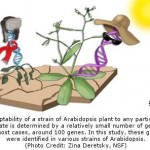Pasadena, California – East Africa’s Turkana Basin has been a hot savanna region for at least the past 4 million years – including the period of time during which early hominids evolved in this area – says a team of researchers led by scientists at the California Institute of Technology (Caltech). These findings may shed light on the evolutionary pressures that led humans to walk upright, lose most of our body hair, develop a more slender physique, and sweat more copiously than other animals.
Their findings – which were based on measurements of the spatial distribution and concentrations of isotopes in carbonate ions – are being reported this week in the early online edition of the Proceedings of the National Academy of Sciences (PNAS).
“When you measure the temperature of the ground, you learn a lot about the environment above it,” says John Eiler, Robert P. Sharp Professor of Geology and Professor of Geochemistry at Caltech. In fact, he says, soil temperature tells you not just about air temperature, but about whether there were trees and plants to shade the soil, keeping temperatures cooler during the hottest part of the day.
Today, Northern Kenya – where the Turkana Basin is found – is among the warmest areas on earth. It has little canopy forest, leaving the ground exposed to sunlight. “The question is, was the ground here ever cooler than it is today?” asks Eiler. “And if it was, why? Was it because the air was cooler, or because of more forest shading?”
To find out, the team examined the spatial organization (or “clumping”) of rare, naturally occurring isotopes of carbon and oxygen – specifically, Carbon-13 and Oxygen-18 – in the form of carbonate ions that are constituents of minerals found in buried soils from northern Kenya. The clumping of these isotopes, Eiler and his colleagues have demonstrated in previous papers, is dependent on temperature: Hot temperatures lead to less clumping; cold temperatures, more.
“These carbonates are a common constituent of these soils,” Eiler explains. “If you have the ability to measure their isotopes, then you have a ground-temperature thermometer.”
When the researchers applied that thermometer to various layers of buried soils from East Africa, they found what Eiler says was “such a straightforward answer, it wasn’t obvious how we could talk ourselves out of the conclusion we reached.”
The conclusion? “The Turkana Basin region – one of the key places where hominid fossils documenting human evolution are found – has been a really hot place for a really long time,” says Benjamin Passey, formerly a postdoctoral scholar at Caltech. Passey, who led the work on this project, is now at John Hopkins University.
But why does it matter how hot Africa was millions of years ago? “This is the area where we find the occurrence of some of the earliest hominid species,” notes Eiler. “It tells us that this environment, though harsh, was a place where our ancestors could thrive. It tells us that they were probably originally marginal species that lived in difficult-to-survive environments.”
The findings also shed some light – and heat – on a longstanding debate over the origin of bipedalism in early humans.
“For a long time, anthropologists have hypothesized that bipedalism and other unique human traits would be advantageous to life in hot savanna environments,” says Passey. “For example, by standing upright, we intercept less direct sunlight than if we were on all fours, and in hot, open environments, the ground and near-surface air can be appreciably hotter than the air a few feet above the ground. So, by standing upright, we are avoiding a high-temperature environment.”
Of course, Passey adds, this strategy would only be of significant use if the environment in question is indeed a high-temperature one. “In cooler environments, these traits do not really have a thermal advantage,” he notes. These considerations led to the team’s interest in figuring out just how hot it was in the part of the world where bipedalism is most likely to have first gained a toehold.
Eiler cautions that the team’s findings are simply assessments of the area’s temperature over time, and have nothing to say about “the importance of ambient temperature in shaping human evolution.” But, he notes, they are “consistent with the notion that the heat in the area would have been a selective pressure that could have made bipedalism advantageous.”
In addition to Eiler and Passey, the coauthors on the PNAS paper, “High-temperature environments of human evolution in East Africa based on bond ordering in paleosol carbonates,” were former Caltech postdoc Naomi Levin, now at Johns Hopkins University; and Thure Cerling and Francis Brown from the University of Utah. Their work was supported by grants from the Camille & Henry Dreyfus Foundation and the National Science Foundation.












